Topics
Category
Era
Minnesota State Fair: Origins and Traditions
The Minnesota State Fair is a yearly celebration of agriculture, crafts, food, and community. In the twenty-first century, nearly 1.8 million people attend the twelve-day event every year, making it the second-largest state fair in the nation. The gathering is a Minnesota tradition that has more than earned its nickname, "The Great Minnesota Get-Together."
Agricultural societies held fairs in Minnesota Territory during the early 1850s. They were designed to showcase the crops, livestock, produce, and handiwork of Minnesota's territorial residents. Fair organizers hoped that displaying proof of Minnesota's productive farms and active social life would encourage immigration to the territory. The first state fair was held in Minneapolis in 1859, and the fair's governing body, the Minnesota State Agricultural Society, was officially chartered the next year.
In its early years the fair had no set location. Between 1860 and 1884, it was held in Minneapolis, St. Paul, Rochester, Redwing, Owatonna, and Winona. Some of these fairs were more successful than others. Between 1874 and 1876, displays were greatly diminished by a grasshopper plague that destroyed many Minnesota crops. When fairs were held outside of their city, Minneapolis citizens organized a competing fair. The traveling state fairs were difficult to organize and often poorly attended.
By the 1880s, the Minnesota State Agricultural Society had decided that the fair needed a permanent home. In 1885, Ramsey County donated land from the county poor farm as a site for the fair. Later that year, the first fair was held on the new fairgrounds situated between St. Paul and Minneapolis, in what would become Falcon Heights. The site ushered in a new era for the Minnesota State Fair.
The State Fair placed the bounties of Minnesota at center stage. In an attempt to lure farmers to the young state, early fairs introduced new breeds of livestock and crops. Exhibits proudly displayed the bushels of wheat and pounds of creamery butter that Minnesota produced. Prized livestock, giant vegetables, and elaborate arrays of farm produce became highlights of each year's fair. These displays were not restricted to agricultural products. The 1876 fair featured an exhibition of ore from the newly established mines on Minnesota's Iron Range.
New agricultural technology often debuted at the fair. The 1860 fair was the first to feature a display of farm machinery. Early state fairs often featured reaper trials and plowing matches that demonstrated the potential of new farm equipment. By 1909, the Machinery Hill area had its own building and space to display a widening range of agricultural equipment. At its height, Machinery Hill took up eighty acres and featured 100 manufacturers.
In addition to agriculture and manufacturing, the Minnesota State Fair celebrated art, craft, and culinary skill. Early fairs set up displays of needlework, handicrafts, and cookery to draw women visitors. Quilt competitions celebrated the artful reuse of textiles. They quickly became an artistic showcase of color, fabric, and embroidery. These exhibits and contests celebrated the essential work of the home—from sewing and quilting to jam-making and bread baking—as an important part of Minnesota life.
In its long history, the Minnesota State Fair has played host to momentous historical events. Theodore Roosevelt delivered his famous line "speak softly and carry a big stick" during a fair speech in 1901. Legendary racehorse Dan Patch set a new record for pacing the mile at the fair's racetrack in 1906. In 1927, the fair made musical history when John Philip Sousa debuted one of his most famous compositions, "The Minnesota March."
The State Fair upholds many longstanding traditions. The Minnesota Dairy Industry has sponsored the Princess Kay of the Milky Way competition since 1954. Nightly grandstand shows and fireworks displays have been a much-loved part of fair life since 1899. But perhaps nothing is more evocative of the Minnesota State Fair than its food. Foods on a stick (including Pronto Pups, introduced in 1947) embody the whimsical spirit that gives the fair its unique character.
Bibliography
Hayes, Gordon. "Minnesota's Wandering State Fair and How it Settled in St. Paul." Ramsey County History 11, no. 1 (Spring 1974): 12–17.
Jarchow, Merrill E. "Early Minnesota Agricultural Societies and Fairs." Minnesota History 22, no.3 (September 1941): 249–269.
http://collections.mnhs.org/MNHistoryMagazine/articles/22/v22i03p249-269.pdf
Koutsky, Kathryn Strand and Linda Koutsky. Minnesota State Fair: An Illustrated History. Minneapolis: Coffee House Press, 2007.
Marling, Karal Ann. Blue Ribbon: A Social and Pictorial History of the Minnesota State Fair. St. Paul: Minnesota Historical Society Press, 1990.
Related Resources
Primary
DeLestry, Edmond L. "The Story of the Fair." Western Magazine 12, no. 2 (August 1918): 44–50.
Midwest Dairy Association Records, 1894, 1904–1991
Manuscript Collection, Minnesota Historical Society, St. Paul
http://www.mnhs.org/library/findaids/00342.xml#a9
Description: Includes association records of State Fair activities including Princess Kay of the Milky Way promotion.
Album 186
State Fair photography album 1906
Sound and Visual Collection, Minnesota Historical Society, St. Paul
Description: Views of Minnesota State Fair buildings and grounds, includes views of building construction. Also views of fairgoers, agricultural exhibits, and event spectators, including grandstand shows and horse races.
http://www2.mnhs.org/library/findaids/sv000311.xml
Minnesota State Agricultural Society Annual and Related Reports, 1887–2007
Manuscript Collection, Minnesota Historical Society, St. Paul
http://www.mnhs.org/library/findaids/gr00093.xml#a9
Description: Contains Minnesota State Fair reports, records of judging, and other related records.
S555. M6 A24
Minnesota State Fair annual program collection, 1947–1984
Minnesota Historical Society, St. Paul
Description: Collection contains Minnesota State Fair programs, souvenirs, and commemorative booklets.
Speer, Ray P. "Recreation Week Is Here: Minnesota's State Fair Will Soon Open." Western Magazine 8, no. 3 (August 1916): 103–109.
———. "The 1918 Minnesota State Fair: This Year's Event of Vital Importance to the Northwest." Western Magazine 12, no. 2 (August 1918): 38–43.
Secondary
S555.M62 A55
Allgeyer, Louis H. The Story of the 1883 Minnesota State Fair Held in Owatonna.
St. Paul: Minnesota Historical Society, 1983.
Baranauckas, Carla. "A Dairy Queen, Oops, Princess, in All Her Buttery Glory." New York Times, August 27, 2005.
http://query.nytimes.com/gst/fullpage.html?res=9B07E7DC1F3EF934A1575BC0A9639C8B63
Marling, Karal Ann. "'She Brought Forth Butter in a Lordly Dish:' The Origins of Minnesota Butter Sculpture." Minnesota History 50, no. 6 (Summer 1987): 218–228.
http://collections.mnhs.org/MNHistoryMagazine/articles/50/v50i06p218-228.pdf
Miller, Susan Lambert. State Fair: The Great Minnesota Get-Together. St. Paul: Minnesota Historical Society Press, 2008.
S555.M62 M675 1915
Minnesota State Fair and Exposition. Minnesota: n.p., c.1915.
Minnesota Historical Society, St. Paul
Roberts, Kate. Minnesota 150: The People, Places, and Things that Shape our State. St. Paul: Minnesota Historical Society Press, 2007.
Speer, Ray P. Minnesota State Fair: The History and Heritage of 100 Years. Minneapolis: Argus Publishing Company, 1964.
Whitehead, John. A State Fair Scrapbook. St. Paul: Twin Cities Public Television, 1993.
Web
Ehrenhalt, Lizzie. "Crazy Quilt." Collections Up Close Podcast and Blog, Minnesota Historical Society, St. Paul, November 13, 2012.
———. "1944 State Fair." Collections Up Close Podcast and Blog, Minnesota Historical Society, St. Paul, January 29, 2013.
———. "Fire at the State Fair Grounds." Collections Up Close Podcast and Blog, Minnesota Historical Society, St. Paul, February 4, 2013.
Fulton, John. "Minnesota State Fair in Archival Film Footage." Collections Up Close Podcast and Blog, Minnesota Historical Society, St. Paul, August 20, 2008.
youtube.com/watch?v=DAzmwjevJL8
Minnesota State Fair. Fair History. https://www.mnstatefair.org/about/media/history/
Minnesota State Fair. Historic Walking & Cell Phone Tour.
https://www.mnstatefair.org/location/history-walking-tour/
Minnesota State Fair Grounds. Placeography Website. https://www.placeography.net/Minnesota_State_Fair_Grounds
Williamson, Lori. "Spectacular Fair: The Minnesota State Fair." Collections Up Close Podcast and Blog, Minnesota Historical Society, St. Paul, August 22, 2011.
http://discussions.mnhs.org/collections/2011/08/spectacular-fair-the-minnesota-state-fair/
Related Audio
Ampers Podcast: MN90: My State Fair is Bigger than Your State Fair
Minnesota State Fair employee Brienna Schuette considers whether the Great Minnesota Get-Together can claim to be the biggest state fair in the United States.
All rights reserved
Related Images
Dress made out of butter cartons used at the 1965 Minnesota State Fair to promote the American Dairy Association of Minnesota. The dress has a Bertha collar and center back zipper; hook-and-eye closure at the collar; and a matching lined cape-let with a center front opening and plain rounded neckline edged in rick rack. A band with hidden buttons and snaps holds the cape and neckline in place. The A-line skirt has a waistline band with two plastic buttons and buttonholes in front and an inverted front pleat edged in rick rack. Round-cornered squares have been cut out from one-pound butter cartons representing various Minnesota creameries and machine-stitched onto the cape and skirt in horizontal rows to a stiffened interfacing.
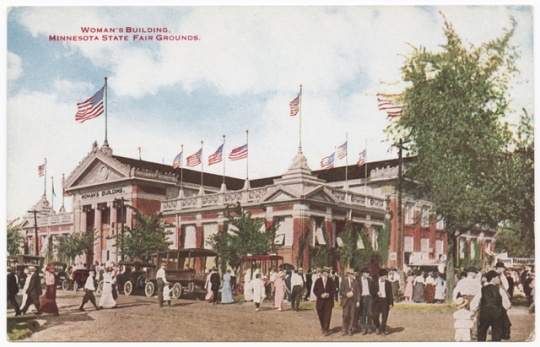
Woman's Building, State Fair
Colored postcard of the Minnesota State Fair Domestic Arts and Handicrafts building, c.1910.
Public domain
Holding Location
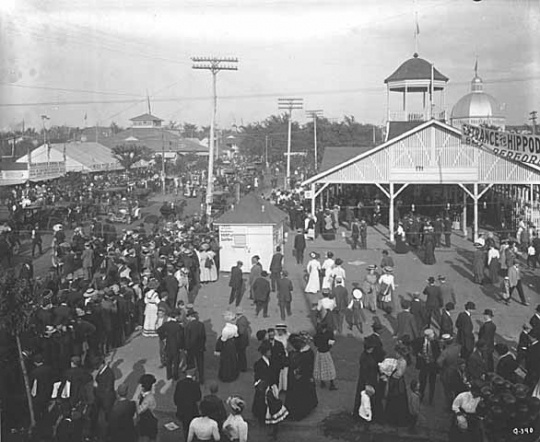
View of Crowd at the State Fair
A view of the crowd at the Minnesota State Fair, c.1910.
Public domain
Holding Location
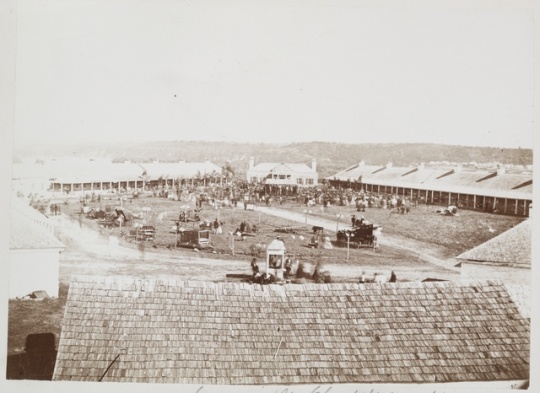
State Fair at Fort Snelling
Photograph of 1860 State Fair at Fort Snelling, 1860–1863.
Public domain
Holding Location

Kittson County horticulture exhibit, State Fair
Kittson County horticulture exhibit, second premium winner at the 1916 Minnesota State Fair.
Public domain
Holding Location
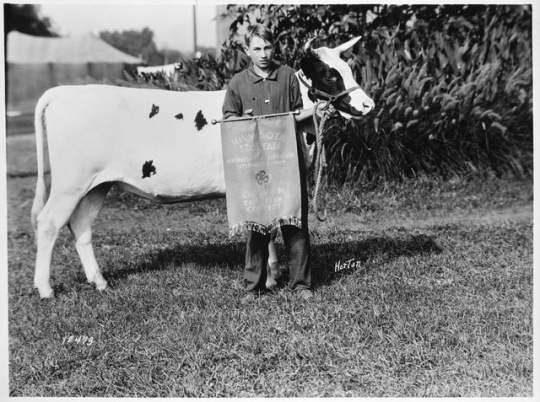
Calf Club champion, State Fair
4H Calf Club champion, Minnesota State Fair, 1923.
Holding Location
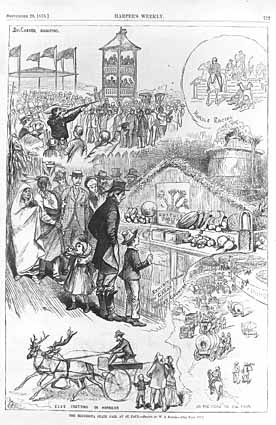
The Minnesota State Fair, At St. Paul.
1878 advertisement featuring the Minnesota State Fair.
Public domain
Holding Location
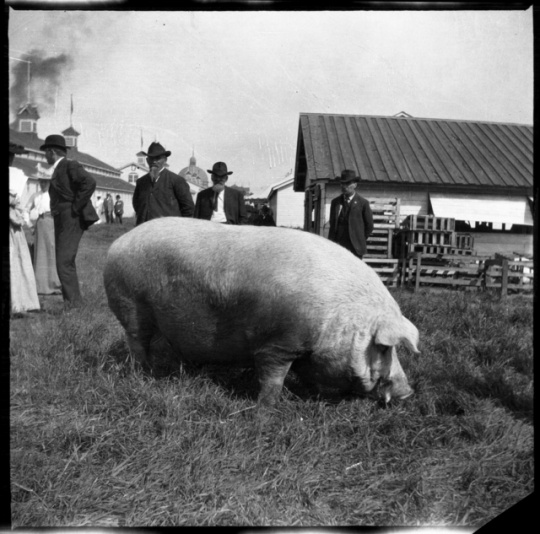
Swine, State Fair
State Fair display swine, 1905.
Public domain
Holding Location
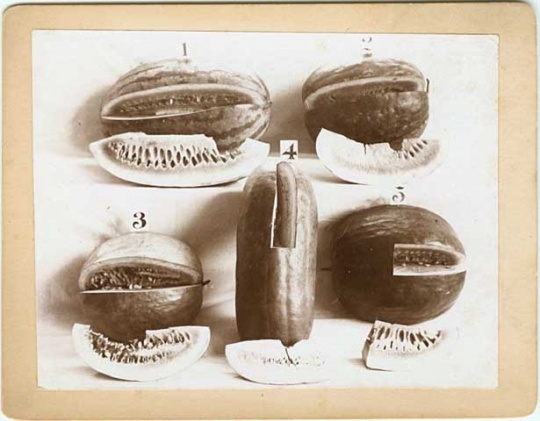
Watermelon display, Minnesota State Fair
Watermelon display, Minnesota State Fair, 1895.
Public domain
Holding Location
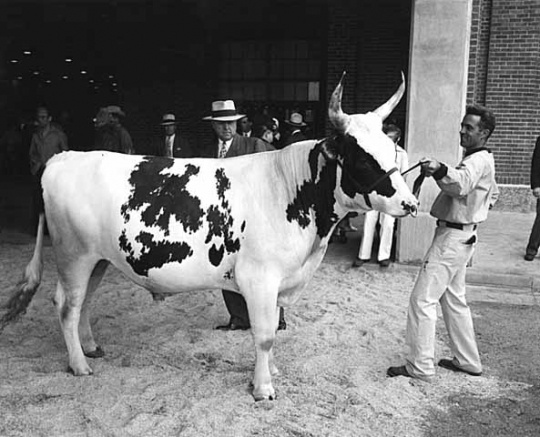
Steer being exhibited
Steer being exhibited, Minnesota State Fair, 1947.
Holding Location
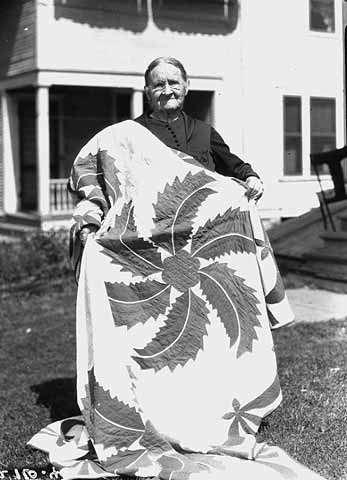
Woman with prize-winning quilt.
Woman with prize-winning quilt, 1926.
Holding Location
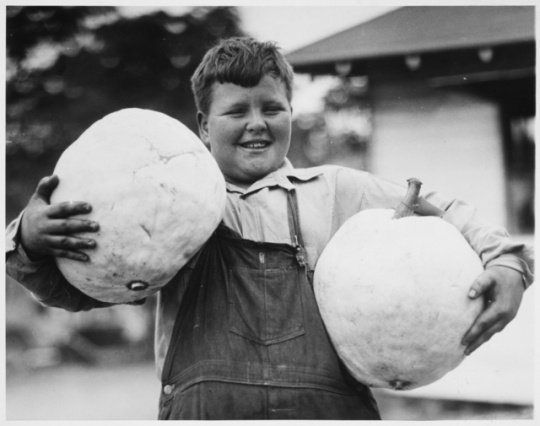
Boy holding squash from Anoka County entered in 1934 State Fair
Boy holding squash from Anoka County; entered in 1934 State Fair, 1934.
Holding Location
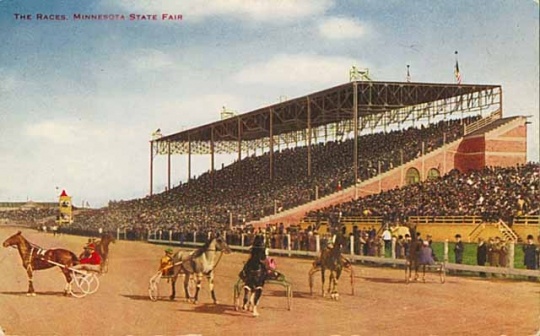
The races, Minnesota State Fair
Postcard depicting harness-racing at the Minnesota State Fair Grandstand, c.1910.
Public domain
Holding Location
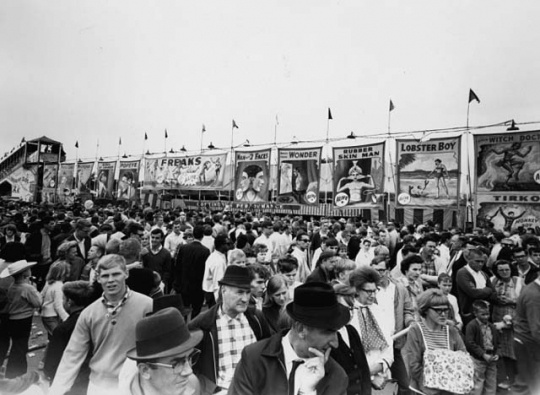
Midway, Minnesota State Fair
Crowds at the Midway, Minnesota State Fair, 1963.
Holding Location
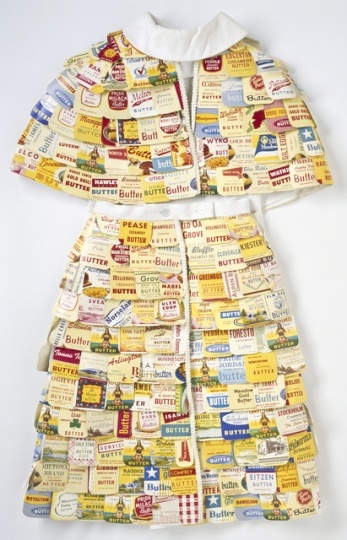
Dress made out of butter cartons used at the Minnesota State Fair
Dress made out of butter cartons used at the 1965 Minnesota State Fair to promote the American Dairy Association of Minnesota. The dress has a Bertha collar and center back zipper; hook-and-eye closure at the collar; and a matching lined cape-let with a center front opening and plain rounded neckline edged in rick rack. A band with hidden buttons and snaps holds the cape and neckline in place. The A-line skirt has a waistline band with two plastic buttons and buttonholes in front and an inverted front pleat edged in rick rack. Round-cornered squares have been cut out from one-pound butter cartons representing various Minnesota creameries and machine-stitched onto the cape and skirt in horizontal rows to a stiffened interfacing.
All rights reserved
Holding Location
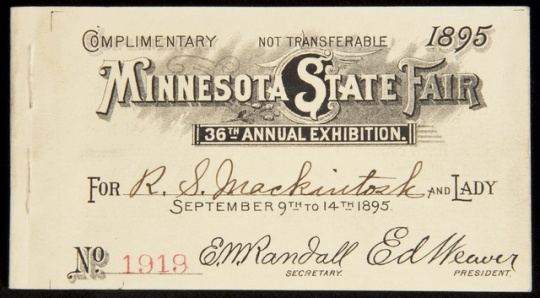
State Fair ticket book
Book of three complimentary tickets permitting Roger Sherman Mackintosh and a female guest to attend the 1895 Minnesota State Fair, held between September 9th and 15th. The book originally contained six tickets; tickets 1, 2, 3 and 5 have been removed.
Public domain
Holding Location
Related Articles
Turning Point
In 1885, the Minnesota State Agricultural Society holds the first fair at the newly built permanent fairgrounds, midway between Minneapolis and St. Paul.
Chronology
1854
1859
1861
1862
1885
1893
1901
1927
1945
1946
1947
1954
2020
Bibliography
Hayes, Gordon. "Minnesota's Wandering State Fair and How it Settled in St. Paul." Ramsey County History 11, no. 1 (Spring 1974): 12–17.
Jarchow, Merrill E. "Early Minnesota Agricultural Societies and Fairs." Minnesota History 22, no.3 (September 1941): 249–269.
http://collections.mnhs.org/MNHistoryMagazine/articles/22/v22i03p249-269.pdf
Koutsky, Kathryn Strand and Linda Koutsky. Minnesota State Fair: An Illustrated History. Minneapolis: Coffee House Press, 2007.
Marling, Karal Ann. Blue Ribbon: A Social and Pictorial History of the Minnesota State Fair. St. Paul: Minnesota Historical Society Press, 1990.
Related Resources
Primary
DeLestry, Edmond L. "The Story of the Fair." Western Magazine 12, no. 2 (August 1918): 44–50.
Midwest Dairy Association Records, 1894, 1904–1991
Manuscript Collection, Minnesota Historical Society, St. Paul
http://www.mnhs.org/library/findaids/00342.xml#a9
Description: Includes association records of State Fair activities including Princess Kay of the Milky Way promotion.
Album 186
State Fair photography album 1906
Sound and Visual Collection, Minnesota Historical Society, St. Paul
Description: Views of Minnesota State Fair buildings and grounds, includes views of building construction. Also views of fairgoers, agricultural exhibits, and event spectators, including grandstand shows and horse races.
http://www2.mnhs.org/library/findaids/sv000311.xml
Minnesota State Agricultural Society Annual and Related Reports, 1887–2007
Manuscript Collection, Minnesota Historical Society, St. Paul
http://www.mnhs.org/library/findaids/gr00093.xml#a9
Description: Contains Minnesota State Fair reports, records of judging, and other related records.
S555. M6 A24
Minnesota State Fair annual program collection, 1947–1984
Minnesota Historical Society, St. Paul
Description: Collection contains Minnesota State Fair programs, souvenirs, and commemorative booklets.
Speer, Ray P. "Recreation Week Is Here: Minnesota's State Fair Will Soon Open." Western Magazine 8, no. 3 (August 1916): 103–109.
———. "The 1918 Minnesota State Fair: This Year's Event of Vital Importance to the Northwest." Western Magazine 12, no. 2 (August 1918): 38–43.
Secondary
S555.M62 A55
Allgeyer, Louis H. The Story of the 1883 Minnesota State Fair Held in Owatonna.
St. Paul: Minnesota Historical Society, 1983.
Baranauckas, Carla. "A Dairy Queen, Oops, Princess, in All Her Buttery Glory." New York Times, August 27, 2005.
http://query.nytimes.com/gst/fullpage.html?res=9B07E7DC1F3EF934A1575BC0A9639C8B63
Marling, Karal Ann. "'She Brought Forth Butter in a Lordly Dish:' The Origins of Minnesota Butter Sculpture." Minnesota History 50, no. 6 (Summer 1987): 218–228.
http://collections.mnhs.org/MNHistoryMagazine/articles/50/v50i06p218-228.pdf
Miller, Susan Lambert. State Fair: The Great Minnesota Get-Together. St. Paul: Minnesota Historical Society Press, 2008.
S555.M62 M675 1915
Minnesota State Fair and Exposition. Minnesota: n.p., c.1915.
Minnesota Historical Society, St. Paul
Roberts, Kate. Minnesota 150: The People, Places, and Things that Shape our State. St. Paul: Minnesota Historical Society Press, 2007.
Speer, Ray P. Minnesota State Fair: The History and Heritage of 100 Years. Minneapolis: Argus Publishing Company, 1964.
Whitehead, John. A State Fair Scrapbook. St. Paul: Twin Cities Public Television, 1993.
Web
Ehrenhalt, Lizzie. "Crazy Quilt." Collections Up Close Podcast and Blog, Minnesota Historical Society, St. Paul, November 13, 2012.
———. "1944 State Fair." Collections Up Close Podcast and Blog, Minnesota Historical Society, St. Paul, January 29, 2013.
———. "Fire at the State Fair Grounds." Collections Up Close Podcast and Blog, Minnesota Historical Society, St. Paul, February 4, 2013.
Fulton, John. "Minnesota State Fair in Archival Film Footage." Collections Up Close Podcast and Blog, Minnesota Historical Society, St. Paul, August 20, 2008.
youtube.com/watch?v=DAzmwjevJL8
Minnesota State Fair. Fair History. https://www.mnstatefair.org/about/media/history/
Minnesota State Fair. Historic Walking & Cell Phone Tour.
https://www.mnstatefair.org/location/history-walking-tour/
Minnesota State Fair Grounds. Placeography Website. https://www.placeography.net/Minnesota_State_Fair_Grounds
Williamson, Lori. "Spectacular Fair: The Minnesota State Fair." Collections Up Close Podcast and Blog, Minnesota Historical Society, St. Paul, August 22, 2011.
http://discussions.mnhs.org/collections/2011/08/spectacular-fair-the-minnesota-state-fair/
















